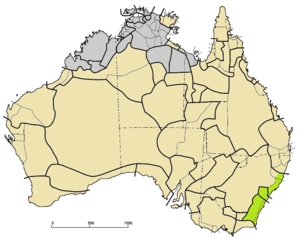|
Yuin–Kuric languages
The Yuin–Kuric languages are a group of mainly extinct Australian Aboriginal languages traditionally spoken in the south east of Australia. They belong in the Pama–Nyungan family.[1] These languages are divided into the Yuin, Kuri, and Yora groups, although exact classifications vary between researchers.[2] Yuin–Kuric languages were spoken by the original inhabitants of what are now the cities of Sydney and Canberra. The name of this grouping was coined by Wilhelm Schmidt in 1919,[3] and it refers to the two groups which define the geographical extent of the subgroup. The labels of all three subgroups reflect the word for 'man' or 'Aboriginal person' in their respective included languages. The koala is named from the word gula for the animal in the Dharug language,[4] a Yuin–Kuri language within the Yora group, and the same word occurs in other Yuin–Kuri languages, such as Gundungurra,[5] within the Yuin group. As of 2020[update], Yuin is listed as one of 20 languages prioritised as part of the Priority Languages Support Project, being undertaken by First Languages Australia and funded by the Department of Communications and the Arts. The project aims to "identify and document critically-endangered languages — those languages for which little or no documentation exists, where no recordings have previously been made, but where there are living speakers".[6] LanguagesThe constituent languages are groups are arranged from southwest to northeast: Yuin groupThe Yuin (southern) group includes:
Yora group The Yora or Iyora (central) group is accepted by Dixon.[8]
They were spoken in the region of Sydney. Kuri groupThe Kuri (northern) group has been reduced to its southernmost languages:
Languages once classified as Kuric include Yugambal, Yuggarabul (Yuggera), and Nganyaywana (Anaiwan) further north. ComparisonJeremy Steele's partial reconstruction of the Sydney language[10] includes a comparison of pronouns in several Yuin–Kuric languages. The following partial and simplified version shows some of the similarities and differences across the family:
References
|
||||||||||||||||||||||||||||||||||||||||||||||||||||||||||||||||

